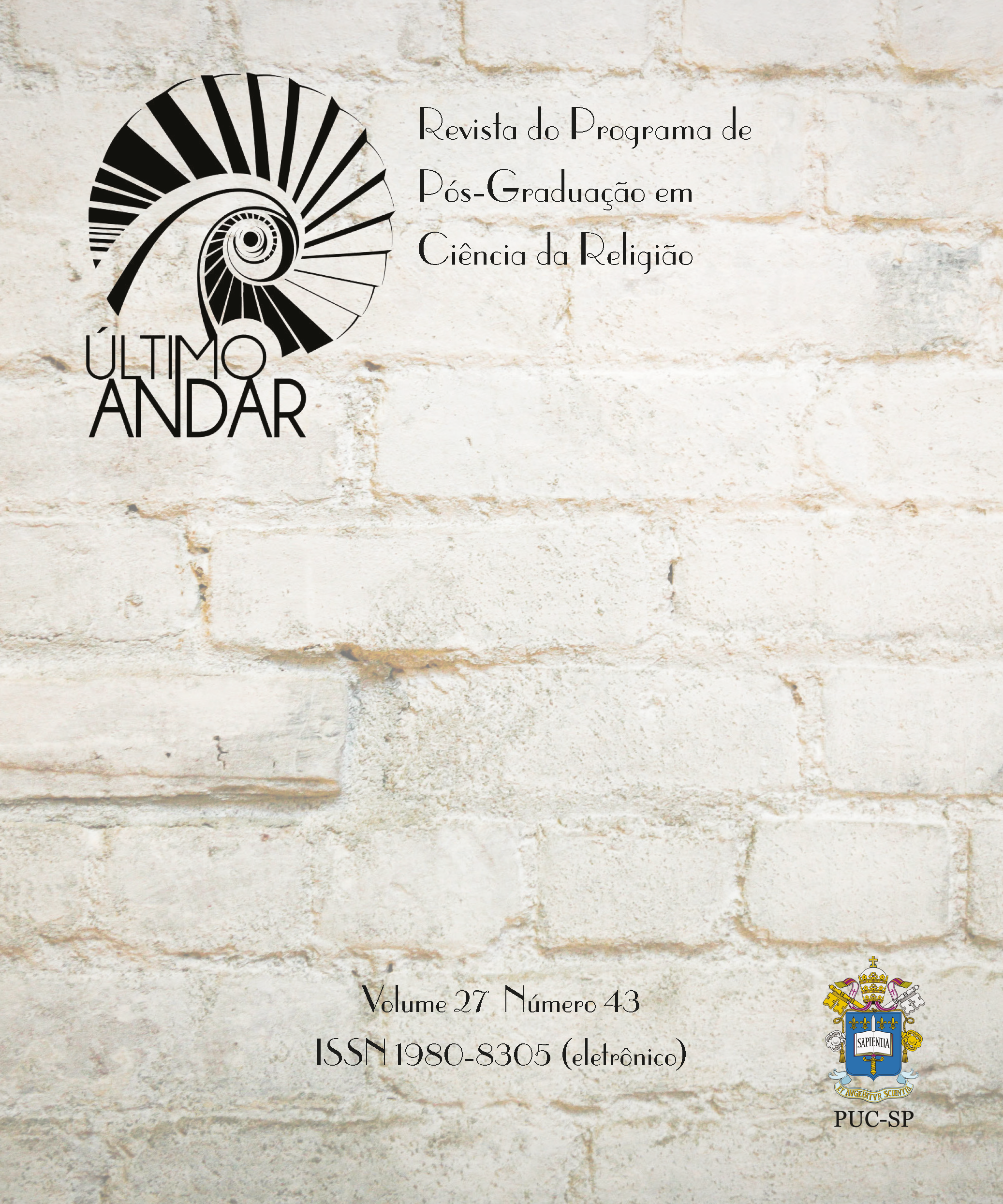On the verge of death
notes on the testament of Abraham
DOI:
https://doi.org/10.23925/ua.v27i43.e62236Keywords:
Testament of Abraham, pseudoepigraphic books, post-exilic Judaism, proto-Christianity, dialogismAbstract
Entering into the study of the pseudo-epigraphic books involves approaching a relevant literary phenomenon within the multifaceted Jewish cultural and religious context, in distinction to the canonical and authoritative assumptions far removed from its locus of conception. With this in mind, this paper set out to analyse the Testament of Abraham as a work with an instigating narrative configuration, a catalyst of meaning for the communities that received it and a participant in the dialogism that permeated Judaism and proto-Christianity. Firstly, a literary presentation of the work was made, through narrative notes that outline the course of the events that make up its three main sections: The hospitality of the elderly Abraham towards the Archangel Michael; Abraham's heavenly journey, led by Michael, as a result of his last request before his death; Death's encounter with Abraham. As a second stage, the article focused on the complex aspects concerning the writing of the text, the possibilities relating to its formation environment and the division of copies into two large groups, recession "A" and "B". Finally, in the third part of the research, we examined the possibility of dialogue between the material in question and some texts found in the New Testament, looking at them in parallel. As a result, a narrative was identified that confronts the anguish of death between ironic scenes and unusual situations, which reflects the pluralism latent in Judaism and the early Christian communities, being an integral and confluent part of the founding imagery of their texts.
References
ALLISON, Dale C. Testamento f Abraham. New York: Walter de Gruyter, 2003. (Commentaries on Early Jewish Literature).
ALLISON, Dale C. Testament of Abraham. New York: Walter de Gruyter, 2003. (Commentaries on Early Jewish Literature).
ALISSON, Dale C. Resurrecting a Calf. The Origin of Testament of Abraham 6:5. Journal of Theological Studies, Oxford, v. 55, n. 1, p. 103-116, 2004.
BAKHTIN, Mikhail. Estética da Criação Verbal. São Paulo: Martins Fontes, 1997.
BÍBLIA DE JERUSALÉM. São Paulo: Paulus, 2002.
BUDGE, Ernest Alfred Wallis. O Livro Egípcio dos Mortos. Trad. Octavio Mendes Cajado. 9. ed. São Paulo: Editora Pensamento, 1993.
COLLINS, John J. A imaginação apocalíptica: uma introdução à literatura apocalíptica judaica. São Paulo: Paulus, 2010. (Coleção Academia Bíblica).
DOBRORUKA, Vicente. Autoria espiritual de livros religiosos do período do segundo templo, experiência visionária, possessão e apocalíptica. Oracula, São Bernardo do Campo, v. 3, n. 6, p. 3-28, 2007.
FISHBURNE, Charles W. I Corinthians III. 10-15 and the Testament of Abraham. New Testament Studies, Cambridge, v. 17, n. 1, p. 109-115, 1970.
FRENKEL, Diana L. La presencia del mundo griego en el Testamento de Abraham. Anales de Filología Clásica, v. 27, p. 49-60, 2014.
HENZE, Matthias. Os Pseudoepígrafos do Antigo Testamento hoje: Os antigos escritos de Israel na pesquisa moderna. In: NOGUEIRA, Paulo Augusto de S. (org.). Apocrificidade: O cristianismo primitivo para além do cânon. São Paulo: Fonte Editorial, 2015.
JOBES, Karen H.; SILVA, Moises. Invitation to the Septuagint. Grand Rapids: Baker Academic, 2015.
KOLENKOW, Anitra Bingham. What is the role of testament in the Testament of Abraham? The Harvard Theological Review, Cambridge, v. 67, n. 2, p. 182-184, 1974.
LUDHOW, Jared. W. Abraham Meets Death: Narrative Humor in the Testament of Abraham. New York: Sheffield Academic Press, 2002. (Journal for the Study of the Pseudepigrapha / Supplement Series 41).
NICKELSBURG, George W. E. Literatura Judaica, entre a Bíblia e a Mixná: Uma introdução histórica e literária. São Paulo: Paulus, 2011. (Coleção Academia Bíblica).
NOGUEIRA, Paulo Augusto de S. Apocrificidade: os apócrifos cristãos no estudo do cristianismo primitivo. In: NOGUEIRA, Paulo Augusto de S. (org.). Apocrificidade: O cristianismo primitivo para além do cânon. São Paulo: Fonte Editorial, 2015.
PROENÇA, Eduardo (org.). Apócrifos e pseudo-epígrafos da Bíblia. Trad. Claudio J. A. Rodrigues. São Paulo: Fonte Editorial, 2017.
SIMKOVICH, Malka Z. Echoes of Universalist Testament Literature in Christian and Rabbinic Texts. Harvard Theological Review, Cambridge, v. 109, n. 1, p. 1-32, 2016.
SMALLWOOD, E. Mary. The Jews Under Roman Rule from Pompey to Diocletian. Leiden: Brill, 2001.
WARREN, Meredith J. Human and divine justice in the Testament of Abraham. In: DI TOMMASO, l.; HENZE, M.; ADLER, W. (ed.). The Embroidered Bible: Studies in Biblical Apocrypha and Pseudepigrapha in honor of Michael E. Stone. Leiden: Brill, 2017. (Studia in Veteris Testamenti Pseudepigrapha, 26).
Downloads
Published
How to Cite
Issue
Section
License
Copyright (c) 2024 Matheus Eduardo de Oliveira Rocha

This work is licensed under a Creative Commons Attribution-NonCommercial 4.0 International License.
The Authors maintain the copyright and grant the journal the right to first publication, with the work simultaneously licensed under the Creative Commons Attribution License that allows the sharing of the work with acknowledgment of authorship and initial publication in this Journal.
Authors are authorized to assume additional contracts separately, for non-exclusive distribution of the version of the work published in this journal (eg, publishing in institutional repository or as a book chapter), with acknowledgment of authorship and initial publication in this journal.
Authors are allowed and encouraged to publish and distribute their work online (eg in institutional repositories or on their personal page) at any point before or during the editorial process, as this can generate productive changes, as well as increase impact and citation of the published work.


